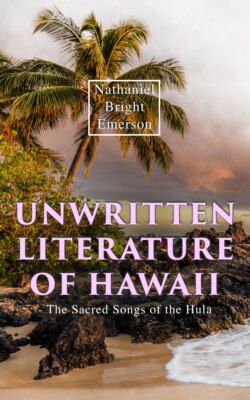Читать книгу Unwritten Literature of Hawaii - The Sacred Songs of the Hula - Nathaniel Bright Emerson - Страница 35
На сайте Литреса книга снята с продажи.
[Translation]
ОглавлениеBehold Kau-kini, a fisher of birds;
Net spread in the mist of Poha-kahi,
That is soaked by the sidling fog.
It strives on the crest of Koa-auwana.
Smoke traps the birds of Pu-o-alii.
It's only the king that I wish:
But stay now--I doubt.
100. Auwana. Said to be an eminence on the flank of Haleakala, back of Ulupalakua.
101. Apua. A place on Hawaii, on Maui, on Oahu, on Kauai, and on Molokai.
102. Mama ula ia ka malua ula. The malua-ula was a variety of tapa that was stained with hili kukui (the root-bark of the kukui tree). The ripe kukui nut was chewed into a paste and mingled with this stain. Mama ula refers to this chewing. The malua ula is mentioned as a foil to the pa-ú, being a cheap tapa.
103. I. A contracted form of ti or ki, the plant or, as in this case, the leaf of the ti, the Dracæna (pl. V). Liloa, the father Of Umi, used it to cover himself after his amour with the mother of Umi, having given his malo in pledge to the woman. Umi may have used this same leaf as a substitute for the malo while in the wilderness of Laupahoehoe, hiding away from his brother, King Hakau.
104. Oloná. A strong vegetable fiber sometimes added to tapa to give it strength. The fibers of olona in the fabric of the pa-ú are compared to the runnels and brooklets of Waihilau.
105. Wai-hilau. Name applied to the water that drips in a cave in Puna. It is also the name of a stream in Wai-pi'o valley, Hawaii.
106. Kilo-hana. The name given the outside, ornamented, sheet of a set (kuina) of five tapas used as bed-clothing. It was also applied to that part of a pa-ú which was decorated with figures. The word comes from kilohi, to examine critically, and hana, to work, and therefore means an ornamental work.
107. Ohe. Bamboo. In this case the stamp, made from bamboo, used to print the tapa.
108. Alá. The hard, dark basalt of which the Hawaiian ko'i, adz, is made; any pebble, or small water-worn stone, such as would be used to hold in place the pa-ú while spread out to dry.
109. Kane-poha-ka'a. Kane-the-hail-sender. The great god Kane was also conceived of as Kane-hekili, the thunderer; Kane-lulu-honua, the earthquake-sender, etc.
110. Wai-manu and Wai-pi'o are neighboring valleys.
111. Ko-a'e-kea. A land in Wai-pi'o valley.
112. Mo' ke kihi. Mo' is a contracted form of moku.
113. Hoaka. The name of the moon in its second day, or of the second day of the Hawaiian month; a crescent.
114. O awili o Malu-á. The most direct and evident sense of the word awili is to wrap. It probably means the wrapping of the pa-ú about the loins; or it may mean the movable, shifty action of the pa-ú caused by the lively actions of the dancer. The expression Malw-á may be taken from the utterance of the king's ilamuku (constable or sheriff) or other official, who, in proclaiming a tabu, held an idol in his arms and at the same time called out Kapu, o-o! The meaning is that the pa-ú, when wrapped about the woman's loins, laid a tabu on the woman. The old Hawaiian consulted on the meaning of this passage quoted the following, which illustrates the fondness of his people for endless repetitions and play upon words:
Awiliwili i ka hale 119 o ka lauwili, e.
He lauwili ka makanl, he Kaua-ula, 120
I hoapaapa i ka hale o ka lauwili, e:
